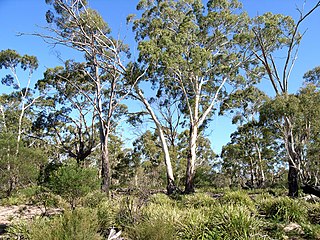
Eucalyptus viminalis, commonly known as the manna gum, white gum or ribbon gum, is a species of small to very tall tree that is endemic to south-eastern Australia. It has smooth bark, sometimes with rough bark near the base, lance-shaped to curved adult leaves, flower buds in groups of three or seven, white flowers and cup-shaped or hemispherical fruit.
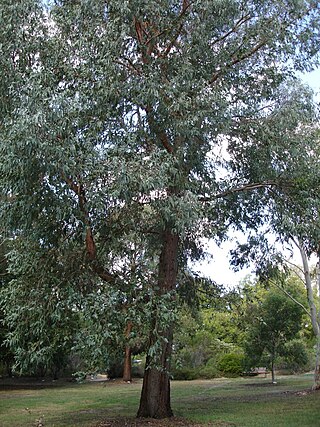
Eucalyptus chapmaniana, commonly known as the Bogong gum, is a species of small to medium-sized tree endemic to montane and eastern Australia. It has rough, fibrous and fissured bark on most of the trunk and smooth light brown to grey bark often shed in long ribbons on the branches. The adult leaves are lance-shaped to curved, the flower buds in groups of three and the fruit a conical or bell-shaped capsule.
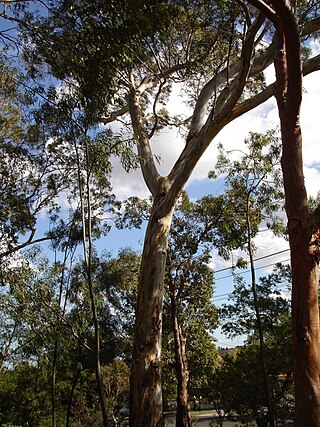
Eucalyptus leucoxylon, commonly known as yellow gum, blue gum or white ironbark, is a species of small to medium-sized tree that is endemic to south-eastern continental Australia. It has smooth yellowish bark with some rough bark near the base, lance-shaped or curved adult leaves, flower buds in groups of three and cylindrical, barrel-shaped or shortened spherical fruit. A widely cultivated species, it has white, red or pink flowers.

Eucalyptus laeliae, commonly known as the Darling Range ghost gum or butter gum, is a species of small to medium-sized tree occurring only on the western side of the Darling Range. It has smooth white, powdery bark, lance-shaped adult leaves, flower buds in groups of between seven and eleven, creamy white flowers and cup-shaped to barrel-shaped fruit.

Eucalyptus elata, commonly known as the river peppermint or river white gum, is a species of medium to tall tree that is endemic to eastern Australia. It has rough, compacted bark on the lower trunk, smooth bark above, lance-shaped to curved adult leaves, green to yellow flower buds arranged in groups of eleven to thirty or more, white flowers and hemispherical or shortened spherical fruit.

Eucalyptus rubida, commonly known as candlebark, ribbon gum or white gum, is a species of small to medium-sized tree that is endemic to south-eastern Australia. It has smooth bark, sometimes with rough bark at the base, lance-shaped or curved adult leaves, flower buds in groups of three, white flowers and cup-shaped, hemispherical or bell-shaped fruit.

Eucalyptus tereticornis, commonly known as forest red gum, blue gum or red irongum, is a species of tree that is native to eastern Australia and southern New Guinea. It has smooth bark, lance-shaped to curved adult leaves, flower buds in groups of seven, nine or eleven, white flowers and hemispherical fruit.

Eucalyptus globulus subsp. bicostata, commonly known as the southern blue gum, eurabbie, blue gum or Victorian blue gum, is a subspecies of tree that is endemic to south-eastern Australia. It has mostly smooth bark with some persistent slabs of old bark at the base, juvenile leaves with one glaucous side, glossy, lance-shaped adult leaves, warty flower buds in groups of three, white flowers and hemispherical to conical fruit.
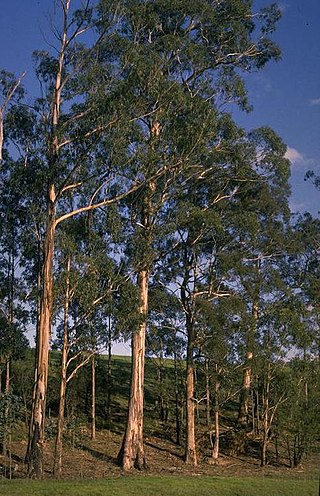
Eucalyptus globulus subsp. maidenii, commonly known as Maiden's gum, is a subspecies of tree that is endemic to southeastern Australia. It has mostly smooth bark with some persistent slabs of old bark at the base, juvenile leaves with one glaucous side, lance-shaped adult leaves, flower buds arranged in groups of seven, white flowers and conical, pedicellate, sometimes glaucous fruit that is more or less square in cross-section

Eucalyptus smithii, commonly known as the gully gum, gully peppermint, blackbutt peppermint, or ironbark peppermint, is a species of medium-sized to tall tree, sometimes a mallee, that is endemic to southeastern Australia. It has rough, compact bark on the trunk, smooth ribbony bark above, narrow lance-shaped adult leaves, flower buds in groups of seven, white flowers and cup-shaped, bell-shaped or hemispherical fruit.

Eucalyptus angophoroides, commonly known as the apple-topped box, apple box or apple gum, is a tree endemic to south-eastern Australia. It has rough, flaky or fibrous bark on its trunk and larger branches, lance-shaped adult leaves, white flowers and conical to hemispherical fruit.

Eucalyptus brookeriana, commonly known as Brooker's gum, is a tree species that is endemic to south-eastern Australia. It has rough, fibrous bark on the lower part of its trunk, smooth bark higher up, lance-shaped, egg-shaped or curved adult leaves, flower buds usually arranged in groups of seven, white flowers and cup-shaped, conical or bell-shaped fruit.

Eucalyptus mannifera, commonly known as the brittle gum or red spotted gum, is a species of small to medium-sized tree that is endemic to south-eastern Australia. It has smooth, powdery white bark, lance-shaped to curved adult leaves, flower buds in groups of seven, white flowers and cup-shaped, hemispherical or conical fruit.

Eucalyptus bridgesiana, commonly known as apple box, apple, apple gum or but-but, is a medium to large sized tree. It has rough, fibrous bark on the trunk and larger branches, smooth grey bark above, glossy green, lance-shaped adult leaves, flower buds in groups of seven, white flowers and hemispherical fruit.
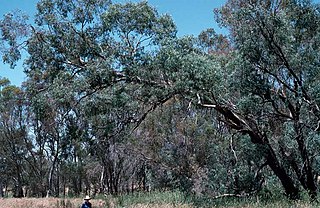
Eucalyptus cadens, commonly known as the tumble-down swamp gum or Warby Range swamp-gum is a small to medium-sized tree that is endemic to a small area in north-eastern Victoria, Australia. It has rough, compacted bark on the trunk and larger branches, smooth bark above, narrow elliptic to lance-shaped adult leaves, flower buds in groups of seven, white flowers and conical fruit.
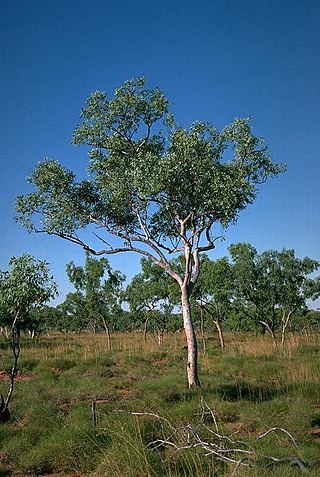
Eucalyptus brevifolia, commonly known as snappy white gum or northern white gum, is a tree that is endemic to northern Australia. It has smooth, powdery white bark, lance-shaped adult leaves, buds arranged in group of seven, white flowers and cup-shaped or barrel-shaped fruit.

Eucalyptus striaticalyx, commonly known as Cue York gum or kopi gum, is a species of tree or mallee that is endemic to Western Australia. It has thick, rough, fibrous bark on the trunk and larger branches, lance-shaped adult leaves, flower buds in groups of between seven and thirteen, creamy white flowers and conical to cup-shaped fruit.
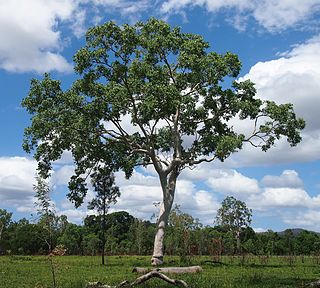
Eucalyptus platyphylla, commonly known as poplar gum or white gum, is a species of medium-sized tree that is endemic to Queensland. It has smooth. powdery bark, heart-shaped, egg-shaped to almost round leaves, flower buds in groups of seven, white flowers and conical to hemispherical fruit.

Eucalyptus umbrawarrensis, commonly known as the Umbrawarra gum, is a small to medium-sized tree that is endemic to the Northern Territory. It has smooth, powdery white bark, narrow lance-shaped adult leaves, flower buds in groups of seven, white flowers and cup-shaped to barrel-shaped fruit.

Eucalyptus alaticaulis, commonly known as the Grampians grey-gum, is a tree or mallee that is endemic to a restricted area in the Grampians National Park in Australia. It has rough, fibrous bark near the base of its trunk, lance-shaped leaves, groups of about seven cylindrical buds with a cone-shaped operculum, white flowers and more or less cylindrical fruit.
























